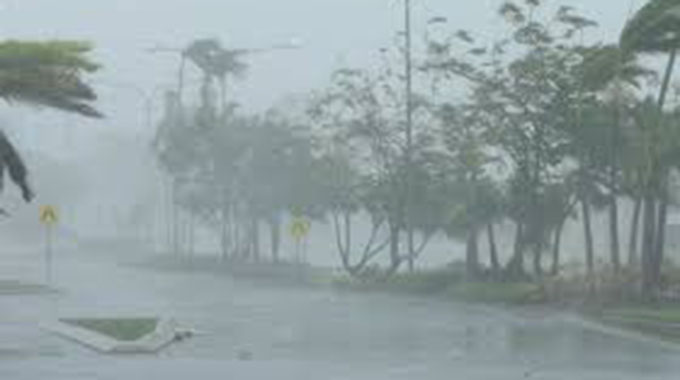Source: Weakened Chalane hits Zim | The Herald
Elita Chikwati Senior Reporter
Tropical Depression Chalane moved into Zimbabwe early yesterday and is now moving across the country towards Botswana, losing strength as it downgrades from a tropical storm to a tropical depression.The storm is bringing heavy rains and there are consequent dangers from flash floods in poorly-drained areas.
Five districts in and close to southern Manicaland are projected to receive above 100 millimetres over the three days between yesterday and tomorrow, with most of the rest of the country expected to receive 50mm to 100mm in the same three days.
Heavy rains and strong winds in Chimanimani saw a few houses lose their roofs and power supplies were disrupted, which has affected water supplies. But people in the lowest lying areas and the camps had been evacuated.
Emergency services remain on high alert and on standby to deal swiftly with any threat.
The downpours may result in reduced visibility and flash flooding in areas with poor drainage as well as along river basins. Mudslides and landslides as well as collapse of walls, due to excessive moisture, remain probable.
Government had moved some people in Chimanimani to safety, but with Chalane weakening had not issued any compulsory evacuation orders.
Awareness campaigns are being carried out through traditional media; television and radio and also through the local leadership to communicate the potential danger to the public.
The Department of Civil Protection, in conjunction with network providers, is disseminating information on Tropical Depression Chalene to the public.
Speaking at the Central Committee meeting yesterday, President Mnangagwa encouraged the general public to remain alert and follow guidance by the Civil Protection Unit, especially in the eastern parts of the country.
Information, Publicity and Broadcasting Services Minister Senator Monica Mutsvangwa said Government had deployed sub-aqua units from the police and personnel from the Zimbabwe Defence Forces (ZDF) to be on standby to assist potential victims, while relevant Government departments were continuously monitoring and tracking the weather system.
Information, Publicity and Broadcasting Services Minister Monica Mutsvangwa briefs journalists on Tropical Depression Chalane and Government’s state of preparedness at Munhumutapa offices in Harare yesterday
Construction companies had volunteered to assist with their earth moving equipment if the need arises and the minister urged people to adhere to warnings from the Meteorological Services Department and the Civil Protection Unit.
“Tropical Depression Chalene is projected to sweep across Zimbabwe from 30 December 2020 to 01 January 2020, causing continuous rainfall and possible flooding in most parts of the country.
“Districts most likely to be affected by Chalene include Chimanimani, Chipinge, Mutare, Buhera and Bikita, with the possibility of receiving above 100mm of rain within three days. The rest of the country is expected to receive rainfall between 50-100 mm during the same period,” she said. Sen Mutsvangwa said Government had, under the Emergency Services Subcommittee, convened its first preparedness planning meeting on December 23 and came up with an action plan.
“Treasury released $100 million towards implementation of the action plan which was distributed among Manicaland, Masvingo, Midlands, Mashonaland East, Mashonaland Central, Matabeleland South and Matabeleland North, Mashonaland West provinces and ZDF.
“We have identified and equipped evacuation centres with tents, blankets, food items, toiletries and other essentials,” she said.
Districts to be affected by the tropical depression had come up with evacuation plans which were being coordinated by the Government and other stakeholders.
“The Ministry of Higher and Tertiary Education, Innovation, Science and Technology Development conducted geo-spatial mapping of the areas likely to be affected and this greatly assisted in evacuation efforts.
“Zupco buses have also been deployed to ferry those in need and willing to be evacuated to places of safety. In Chamanimani, evacuations of people in low-lying areas started on 29 December and to date most people have been evacuated to safer areas,” she said.
She thanked Masimba Constriuction, Fossil Contracting, Bitumen, Tensor, Exodus and J. R Goddard for volunteering to assist with their earthmoving equipment.
Chimanimani East legislator, Cde Joshua Sacco, said they had experienced heavy rains and bursts of winds across the area with some house roofs being blown away.
Cde Sacco
“No major infrastructural damage has been reported as yet on roads and bridges. No injuries or deaths have been reported. Evacuations have been done for those in the camps to Mutambara High and St Patricks in Nyanyadzi,” he said.
He said electricity and mobile network was disrupted as early as 6.45 and authorities were working hard to restore service.
“Please let’s remain indoors in safe zones or if in Red Zones lets evacuate to designated points,” he said.
Zinwa corporate communications and marketing officer, Mr Tsungirirai Shoriwa said the authority was working closely with other stakeholders and partners in Manicaland Province supply potable water for affected communities and at the centres where people evacuated from vulnerable areas are housed.
“Mobilisation of the necessary requirements for provision of the water has already begun and interventions will include provision of water using bowsers, installation of temporary water reticulation systems and where necessary drilling of boreholes,” he said.
Chalane made landfall in the district of Muanza, north of Beira City, in Mozambique’s Sofala Province, in the early hours of yesterday, with moderate rains and winds, according to Mozambique’s National Institute of Meteorology. Areas of Sofala Province that were impacted by Chalane include Dondo, Beira City and Buzi, which were struck by Cyclone Idai in March 2019. Some damage has been reported, including in resettlement sites where people displaced by Cyclone Idai were staying in temporary shelters.



COMMENTS